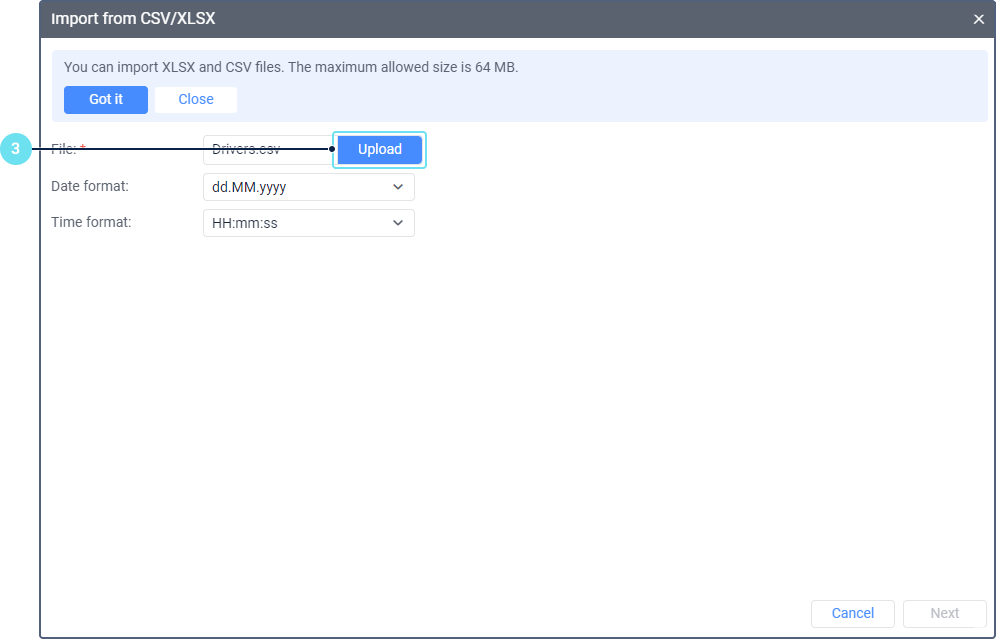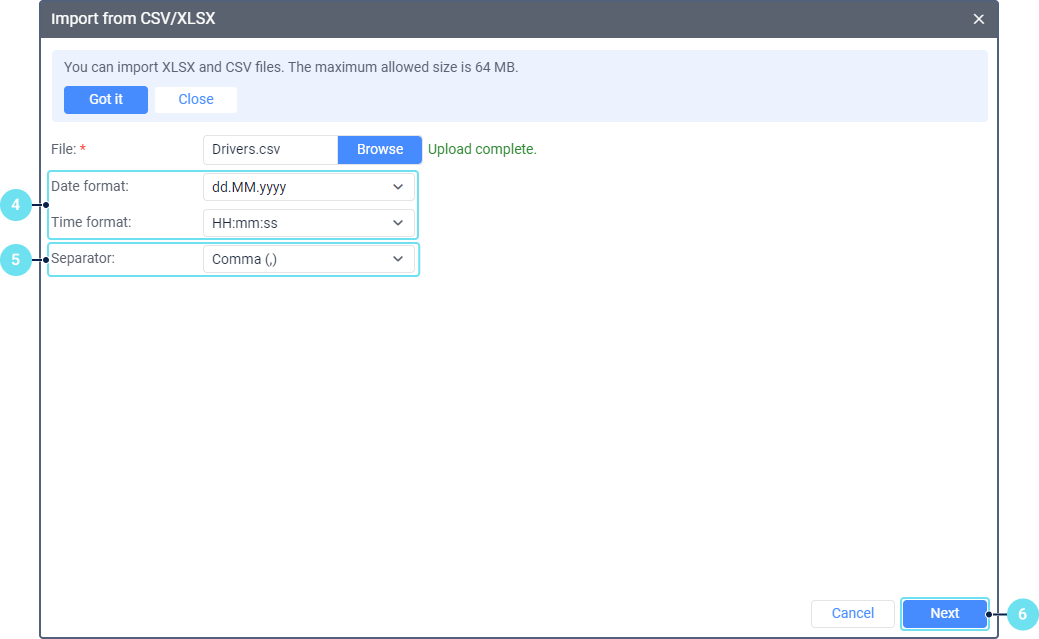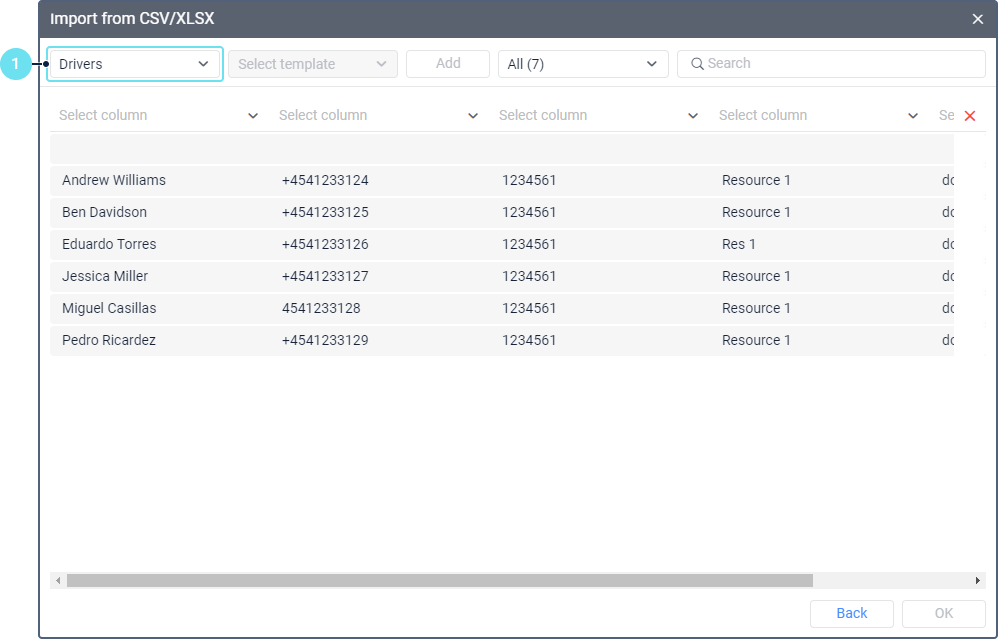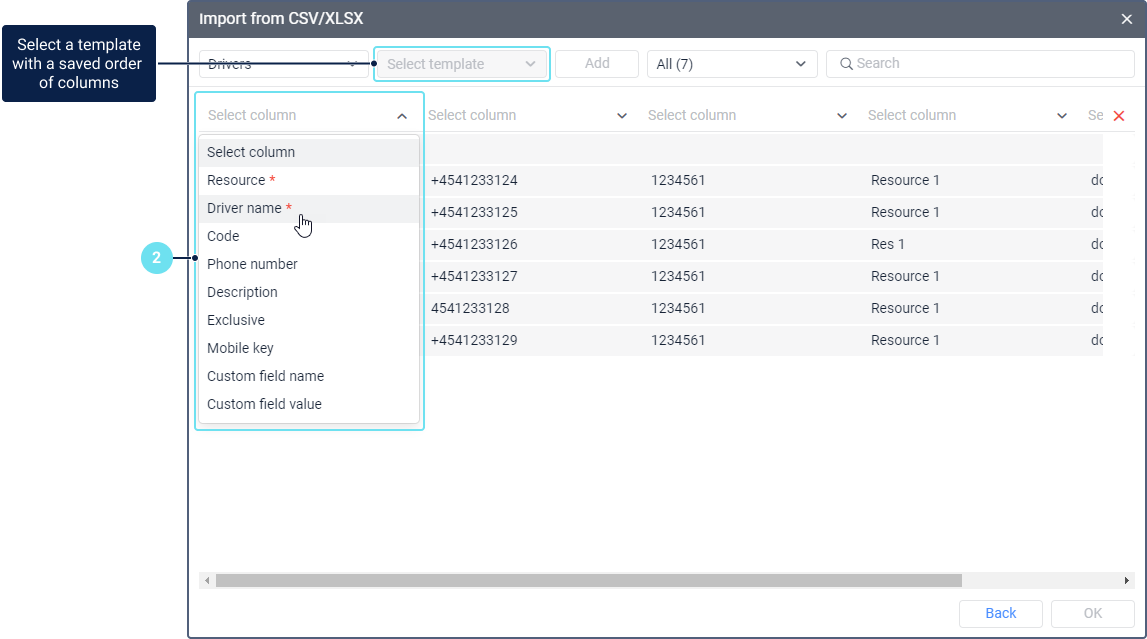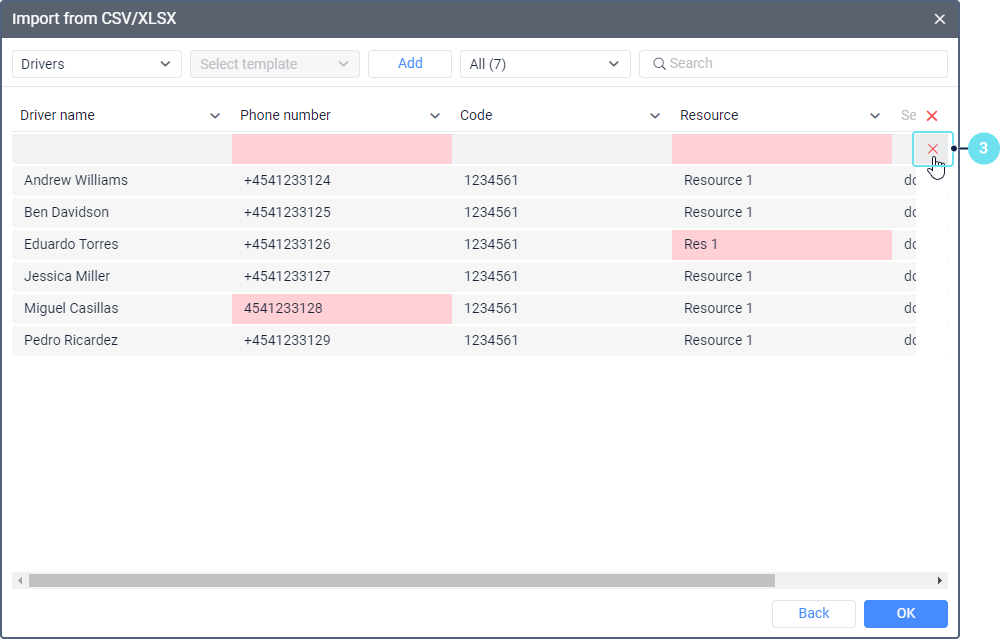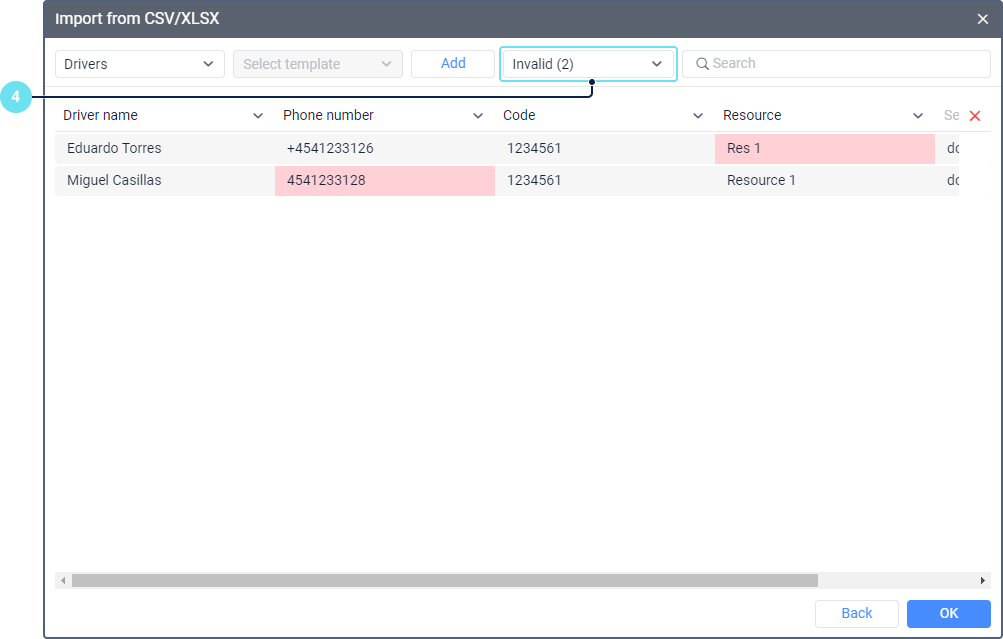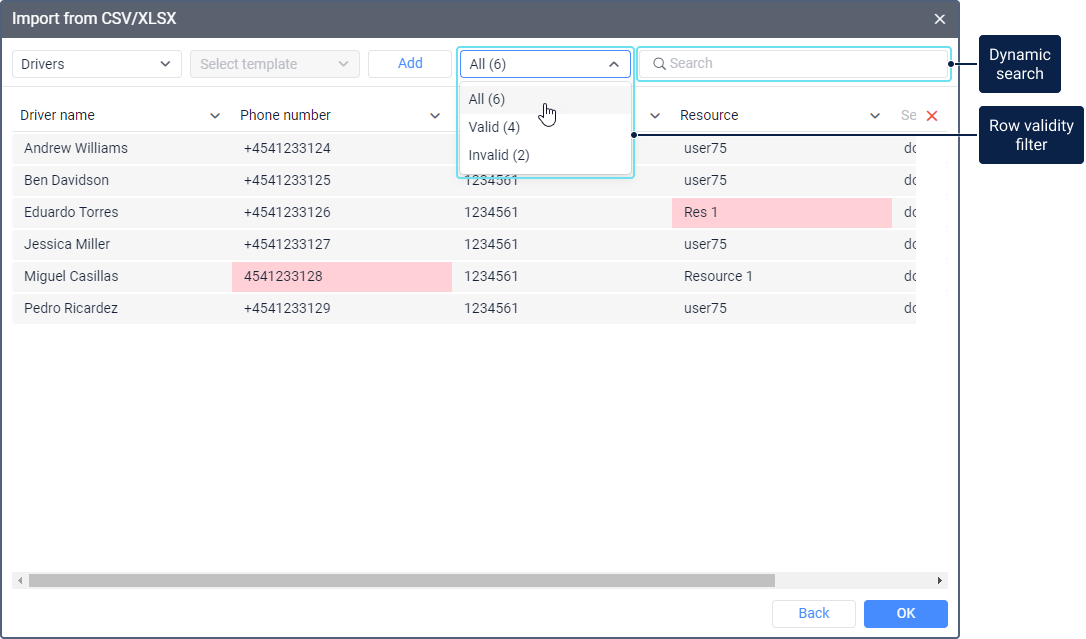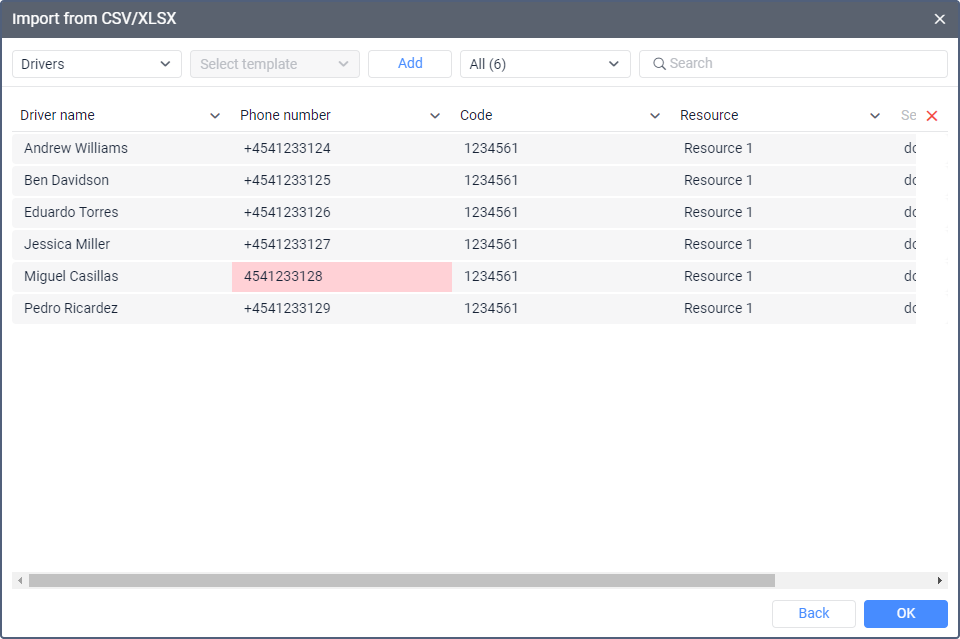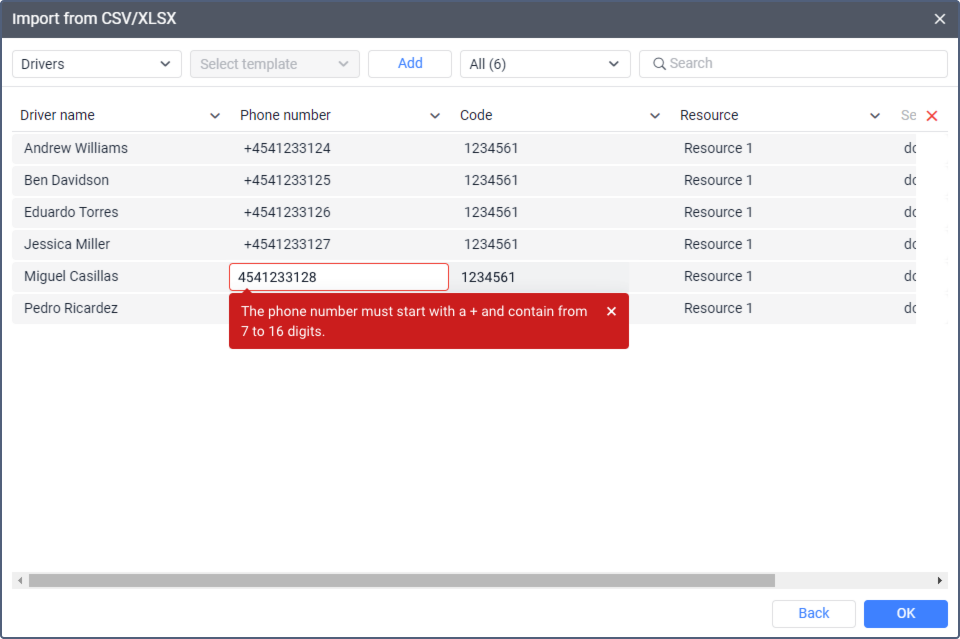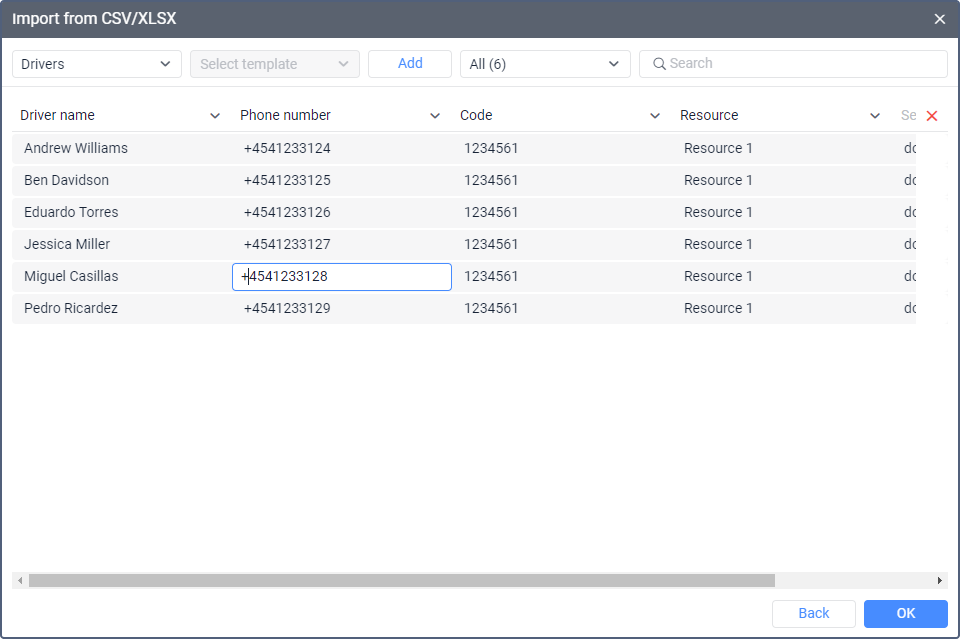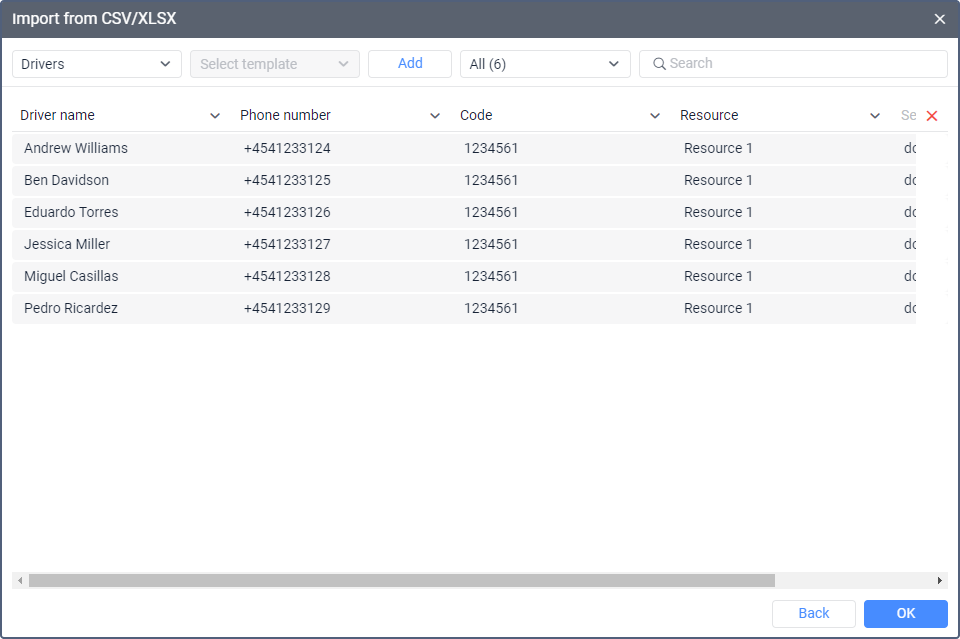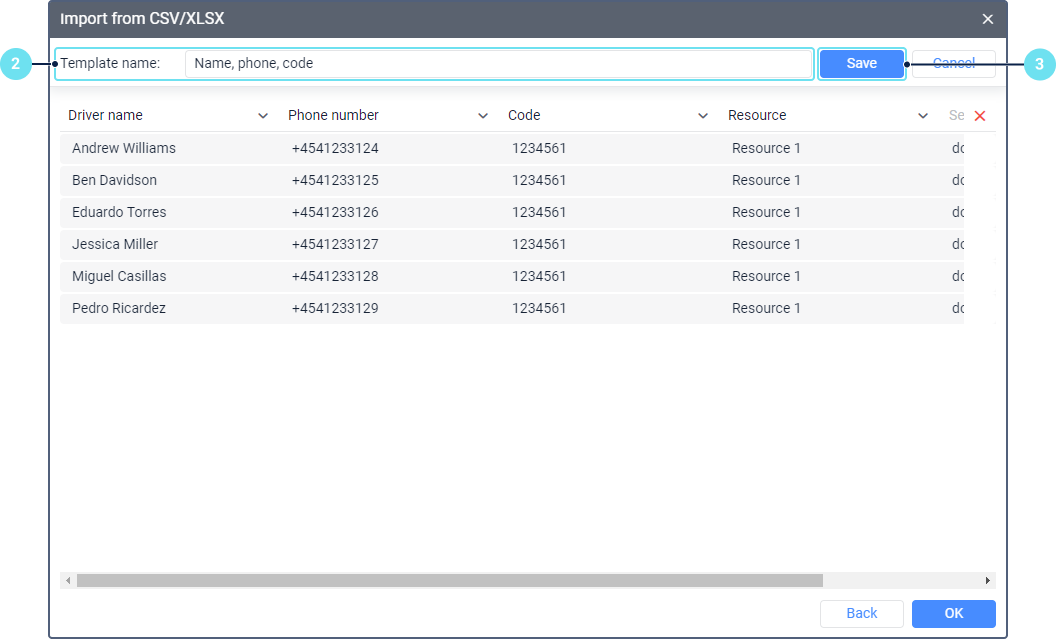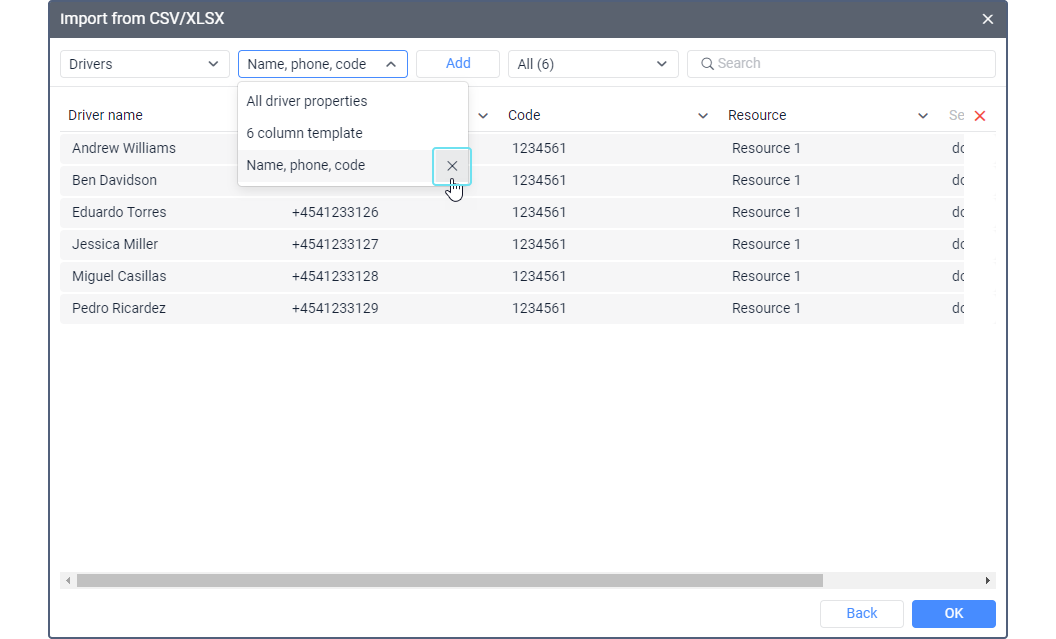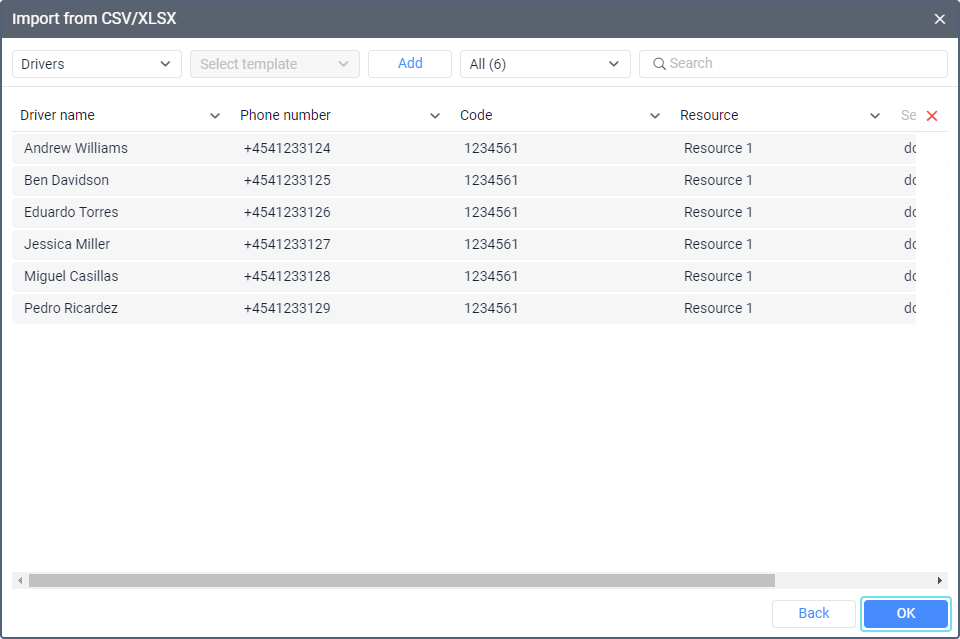The Import from CSV/XLSX feature allows you to import units, fuel fillings and drivers in bulk from CSV and XLSX files into the system.
The import process consists of the following steps:
- uploading the required file;
- preparing a table with data to be imported;
- adding a template (optional);
- completing the import and checking the results.
Read more about each step below.
Uploading the file
To upload the file from which you want to import data, follow the steps below:
- In the user menu, select Import/Export and then select Import from CSV/XLSX.
- Click on the Browse button and select the file you want to upload.
- Click Upload.
- Select the date and time format used in the file.
- For a CSV file, specify the separator: comma, semicolon, colon, or tab.
- Click Next.
The data from the file is then shown as a table which you should prepare for import.
Preparing the table for import
To prepare the uploaded data for import, follow the instructions below.
- Select the type of items you want to import: units, drivers or fuel fillings.
Specify the headings of the columns. To do this, you can apply a previously saved template or select headings from the drop-down lists above the columns. Mandatory headings are marked with an asterisk (*). For a description of all available columns, see the sections Unit import table, Driver import table, Fuel filling import table.
If no name is selected for a column, its contents are not imported into the system.
- If necessary, delete the first line and other unnecessary lines. To do this, point to the line and click on the icon at the end of the line.
- Make sure the table shows valid data. To do this, select Invalid in the filter. If nothing is found by the filter, all rows are valid. If invalid data is found, edit it.
- If necessary, save the template so that you can immediately apply the same column order the next time you import data.
Unit import table
In the table for importing units, you can select the columns listed below. Here you can find their description and the requirements that must be met so that the data in these columns is considered valid.
Mandatory columns are marked with an asterisk (*).
| Column | Description | Requirements |
|---|---|---|
Creator* | The user on whose behalf the unit will be created in the system. After import, the unit will belong to the account of this user. | The user-creator must already exist in the system. It must not be a top-level user. The Can create objects option must be enabled in the properties of this user. In addition, the Units service must be enabled for their account. |
Unit names* | The name under which the unit will be created in the system. | The name of the unit must be 4-50 characters long. |
Phone number | The phone number of the SIM card installed in the device. You can select this name for two columns to specify two phone numbers for one unit. | The phone number must start with + and consist of 7-16 digits. The phone number must not match the number of another unit in the table or in the system or the number of any driver in the system. |
Device type* | The type of the device installed on the unit. | The specified device type must be supported in the system. See the list of supported device types in the Hardware section of the Wialon website. |
Unique ID* | The unique ID of the unit. Read more about the unique ID here. | The unique ID must not be longer than 100 characters. |
Mileage | The value of the mileage counter. | Only whole numbers are allowed. In addition, the value must not be negative. |
Unit group | The name of the group to which the unit will belong after import. | The name of the unit group must consist of 4-50 characters. |
Custom field name | The name of the custom field that will be shown on the Custom Fields tab in the unit properties. You can select this heading for three columns. | No import requirements. |
Custom field value | The value of a custom field that will be shown on the Custom Fields tab in the unit properties. You can select this heading for three columns. | No import requirements. |
VIN | The VIN code of the vehicle, i.e. vehicle identification number. | The VIN must not exceed 17 characters in length. It may contain only Arabic numbers and letters of the Latin alphabet (except for the letters I, O and Q). |
Vehicle type | The type of the vehicle | The specified type must be available in the system. You can find the list of available vehicle types here. |
| Registration plate | The registration plate of the vehicle. | The length of the registration plate must not exceed 60 characters. There must be no spaces at the beginning and end. |
Brand | The brand of the vehicle. | No import requirements. |
Model | The model of the vehicle. | No import requirements. |
Year | Year of manufacture of the vehicle. | The value must consist of 4 digits. There must be no spaces at the beginning and end. |
Driver import table
In the table for importing drivers, you can select the columns listed below. Here you can find their description and the requirements that must be met so that the data in these columns is considered valid.
Mandatory columns are marked with an asterisk (*).
| Columns | Description | Requirements |
|---|---|---|
Resource* | The resource to which you want to import the driver. | The name of the resource must match the name of an existing resource in the system. Also, the Drivers service must be activated for the account to which this resource belongs. |
Driver name* | The name of the driver. | No import requirements. |
Code | The driver's unique identification number. See details. | No import requirements. |
Phone number | The phone number of the driver. | The phone number must start with + and consist of 7-16 digits. The phone number must not match the number of another driver in the table or in the system or any unit in the system. |
Description | The description of the driver. | No import requirements. |
Exclusive | The Exclusive option. For a detailed description of the option, see here. | The allowed values are 1 (enabled) and 0 (disabled). |
Mobile key | The password required by the driver to log in to the Logistics Mobile application. | No import requirements. |
Custom field name | The name of the custom field that will be shown in the driver properties. You can select this heading for three columns. | No import requirements. |
Custom field value | The value of a custom field to be shown in the driver properties. You can select this heading for three columns. | No import requirements. |
Fuel filling import table
In the table for importing fuel fillings, you can select up to 6 columns. Here you can find their description and the requirements that must be met so that the data in these columns is considered valid.
Mandatory columns are marked with an asterisk (*).
| Column | Description | Requirements |
|---|---|---|
Unit* | The name of the unit for which you want to import fuel fillings. | Units with the specified names must be created in the system. In addition, you must have the Manage events access rights to these units. |
Date* | The date and time of the fuel filling, i.e. the highest fuel level difference. | The date and time must be in the format selected when uploading the file. |
Location | The address or coordinates of the unit at the time of the fuel filling. | No import requirements. |
Volume* | The amount of fuel filled. | The volume of the fuel filling must be specified without units of measurement. The column can contain only whole and fractional numbers with a dot as a separator. The volume value can't be negative. |
Cost* | The cost of the fuel filled. | The cost of the fuel filling must be specified without units of measurement. The column can contain only whole and fractional numbers with a dot as a separator. The value can't be negative. In reports, you can see the data on the fuel filling cost only in the Utilization cost table. |
Description | The comment on the fuel filling. | No import requirements. |
Searching and filtering data
You can search the data in the table and filter it by validity.
To find a specific item in the table, use the dynamic search. You can search for units and drivers by name, and for fuel fillings by unit name. If the Unit name or Driver name columns are not selected in the table, the search is not available.
To the left of the search bar, there is a filter that allows you to choose which rows you want to see in the table: all, valid, or invalid. By default, all rows are shown. To the right of the All option, you can see the total number of rows in the table.
If a number other than zero is shown in brackets to the right of the Invalid option, select this option and edit the found rows. Otherwise, they will not be imported.
Editing data
Cells with invalid data are highlighted in red color in the table. It is impossible to import items with such cells.
You can correct invalid data as follows:
- Click on a red cell.
- Read the tooltip to find out why the error occurred.
- Enter the correct data.
- Click outside the cell to save the changes.
When editing data in most columns, you must take into account special requirements. They are described in the sections Unit import table, Driver import table, Fuel filling import table.
Adding a template
Once you have selected the column headings, you can add a template, that is, save the order of the table columns. This is not a mandatory step, but it will save you time during your next import. Instead of selecting column headings manually, you will be able to select the template and the saved column order will be automatically applied to the table.
Adding a template is only available when all mandatory column headings are selected.
To add the template, follow the steps below.
- Click Add.
- Specify the template name (max. 50 characters).
- Click Save.
The added template is shown in the list of templates.
To delete a template, hover over its name in the list and click on the icon .
Completing the import and checking the results
To complete the import, click ОК.
Importing a large number of items may take some time.
If the import of at least one item is successful, the pop-up message Import completed is shown. In the opposite case, you can see the message that the data couldn't be imported. When importing units, this message also contains a file with information about the errors that occurred. You can download it.
After import, units are saved in the account of the user specified as their creator. Fuel fillings are saved in the unit history and drivers are saved in the resources.
You can see the imported units in the Units section of the management system and on the Units, Monitoring (if the Automatic addition of units to the work list feature is enabled) and other tabs of the monitoring sytem.
You can see the imported drivers on the Drivers tab of the monitoring system.
To see the imported fuel fillings, run a report with the Fuel fillings and battery charges table for the required time period. You can see the Cost column only in the Utilization cost table.




